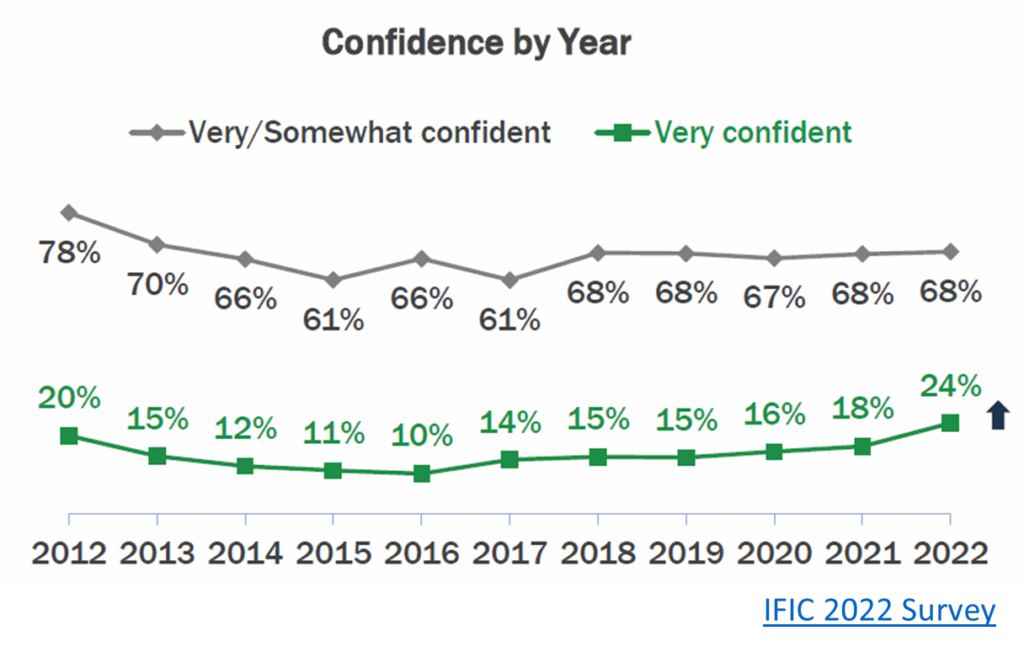Consumers cite foodborne illness from bacteria such as E. coli, Salmonella and Listeria as their top food safety concern. While the majority of those (66%) are satisfied with what is currently being done to protect the food and consumers, this also means that 34% of consumers are not satisfied with the steps being taken for protection. This finding, along with the others from the International Food Information Council (IFIC) 2022 Food and Health Survey, should provide the food industry with both a sense of satisfaction and a sense of responsibility to do better.
The paradox is illustrated as well by the trends in general consumer confidence in the safety of US food supply, as shown by the IFIC survey. The percentage of those who are “very confident” in the safety of the U.S. food supply is shown to be slightly higher in 2022 than the first year tracked by the survey (2012). However, the overall feeling of confidence (as shown when the “somewhat confident” responses are added) has decreased significantly since 2012, remaining fairly stable at 68% in recent years. But, again, even with about 2/3 of respondents stating confidence in food safety, it means 1/3 of consumers are not confident that their food is safe.

In fact, with the exception of GMOs, none of the top concerns had a satisfaction rating of more than about 2/3. This becomes even more concerning when the average satisfaction rating of all top concerns is calculated – showing that nearly half (45%) of the respondents are dissatisfied with the food safety of what they see as a top concern.
| Top concern1 | Satisfied2 | Food Safety Issue |
| 50% | 66% | Foodborne illness from bacteria (E. coli, Salmonella, Listeria, etc.) |
| 45% | 46% | Carcinogens or cancer-causing chemicals in food |
| 42% | 50% | Pesticides/pesticide residues |
| 38% | 41% | Heavy metals in food (arsenic, mercury, lead, cadmium) |
| 34% | 53% | Food additives/ingredients (caffeine, MSG, flavors, colors, preservatives, etc.) |
| 25% | 61% | The presence of allergens in food |
| 23% | 51% | Antibiotics |
| 21% | 58% | Bioengineered food/Food that contains bioengineered ingredients |
| 20% | 71% | GMOs |
| 1Ranked as top 3 of 9 listed issues 2Very or somewhat satisfied with consumer protection IFIC 2022 Survey |
While one may try to push this aside as being more perception than fact, when it comes to consumer spending, perception begets reality. A consumer who is dissatisfied with the amount of effort industry puts into ensuring against pesticides and their residues is likely to pass over conventional products for organic. A consumer concerned about heavy metals – and likely seeing the many recent news articles about this – will avoid any foods that have been associated by media or social media reports (true or not). A consumer concerned with antibiotics may pay a higher price to see “antibiotic-free” on the label or may avoid some meats altogether. And while GMO and bioengineered foods have been proven to be safe, compliance with the National Bioengineered Food Disclosure Law became mandatory as of January 1, 2022.
Additionally, on any given day, you can find multiple media and social media reports about “unsafe” foods – from pesticides to food additives to GMOs. Take for example EWG’s annual “Dirty Dozen,” for which the 2022 list focuses on pesticides in produce. Not only does the list include a top 12, it expands to 44 implicated produce items – with no explanation, just item name and photo. Then the page adds a note about a few additional vegetables “produced from genetically modified seeds.” EWG’s list is generally highly replicated in the media, as evidence by the search term “EWG dirty dozen” bringing up 26,400 results.
Not only do all these show that industry needs to pay attention to consumer concerns and communicate what you are doing to keep food safe – because there are plenty who are communicating what they perceive the industry is not doing. These also show how consumer perception steers the food industry, both processors and regulators, how perception becomes reality.
And when the industry does have an issue, particularly when a well-known brand is implicated and susceptible individuals are the primary consumer, the media has a heyday questioning the activities and diligence of both processors and regulators. It brews a perfect storm for regulatory backlash and increased oversight and enforcement – not only on the implicated segment but on the industry as a whole, as we expect we will be seeing from some of the recent extensive and highly publicized recalls.





